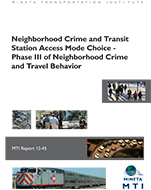- 408-924-7560
- mineta-institute@sjsu.edu
- Donate
Neighborhood Crime and Transit Station Access Mode Choice – Phase III of Neighborhood Crime and Travel Behavior
This report provides the findings from the third phase of a three-part study about the influences of neighborhood crimes on travel mode choice. While previous phases found evidence that high levels of neighborhood crime discourage people from choosing to walk, bicycle and ride transit, consistent with the authors’ hypothesis, they also produced counterintuitive findings suggesting that in some cases, high crime neighborhoods encourage transit ridership at the expense of driving—the opposite of what common sense would suggest. Phase 3 tested possible explanations for these counterintuitive findings with a series of methodological improvements. These improvements were:
- Improvement 1: Used the Bay Area Rapid Transit (BART) system‘s 2008 Station Profile Survey travel data set to replace the Bay Area Travel Survey (BATS) 2000 data used in previous phases.
- Improvement 2: Separated drop-off and drive-alone modes in logit models.
- Improvement 3: Variables at the corridor level replaced previous variables at the transportation analysis zone (TAZ) level.
- Improvement 4: Average parcel size (APS) variable replaced the intersection density measure of urban design.
- Improvement 5: Used nested logit modeling techniques.
These yielded strong evidence supporting the hypothesis that high-crime neighborhoods encourage driving, and they generated none of the counterintuitive findings from previous phases.
CHRISTOPHER E. FERRELL, PhD
Dr. Ferrell began his planning career in 1995 working for the San Francisco Bay Area’s Metropolitan Transportation Commission (MTC) on Intelligent Transportation System (ITS) applications for traffic management. Since 2000, he has worked as a transportation consultant, and in 2010 he co-founded CFA Consultants, a transportation planning and research firm. Dr. Ferrell completed his doctoral studies in City and Regional Planning at the University of California at Berkeley in 2005. His studies focus on the relationships between transportation and land use. His research experience includes the evaluation of transit facilities, transportation policy analysis, transportation and land use interactions, travel behavior, and the analysis of institutional structures. As a practitioner, he has developed traffic impact studies for mixed-use, infill and transit-oriented projects; analyzed the impacts of specific and general plans and planned and implemented intelligent transportation systems; and developed bicycle and pedestrian plans. He recently completed TCRP Report 145—Reinventing the Urban Interstate: A New Paradigm for Multimodal Corridors. He has also taught several graduate planning classes in the San José State University Urban Planning Department and the University of California, Berkeley City and Regional Planning Department.
SHISHIR MATHUR, PhD
Dr. Mathur is a professor of Urban and Regional Planning at San Jose State University. He obtained PhD (2003) in Urban Design and Planning from the University of Washington, Seattle, and Masters (1997) in Urban Planning from the School of Planning and Architecture, New Delhi, India. He has worked as an urban planner in the USA and India. His professional work in the USA includes research, teaching and consulting in urban economics, housing, public finance, growth management, land use planning, infrastructure planning, strategic planning, and systems analysis. In India, he consulted in physical and land use planning, infrastructure finance, project management, architecture, and urban design. For a complete listing of his publications, see http://works.bepress.com/shishirmathur/.
BRUCE APPLEYARD, PhD
Dr. Appleyard is a principal with the planning and research firm, CFA Consultants, and an assistant professor of Urban Planning at San Diego State University. He has over 20 years of experience working as a planner and urban designer, focusing on the intersection between transportation, design, and environmental quality in support of a diverse range of sustainability and livability objectives. Dr. Appleyard is passionate about helping people bridge the technical and regulatory barriers to creating joyful and enriching communities that reflect their spirit and identity. For his work with communities to improve their livability, safety, and health, he was recognized by the Robert Wood Johnson Foundation as one of their “Top-Ten Active Living Heroes,” alongside Dan Burden and then-Senator Barack Obama.
-
Contact Us
San José State University One Washington Square, San Jose, CA 95192 Phone: 408-924-7560 Email: mineta-institute@sjsu.edu






